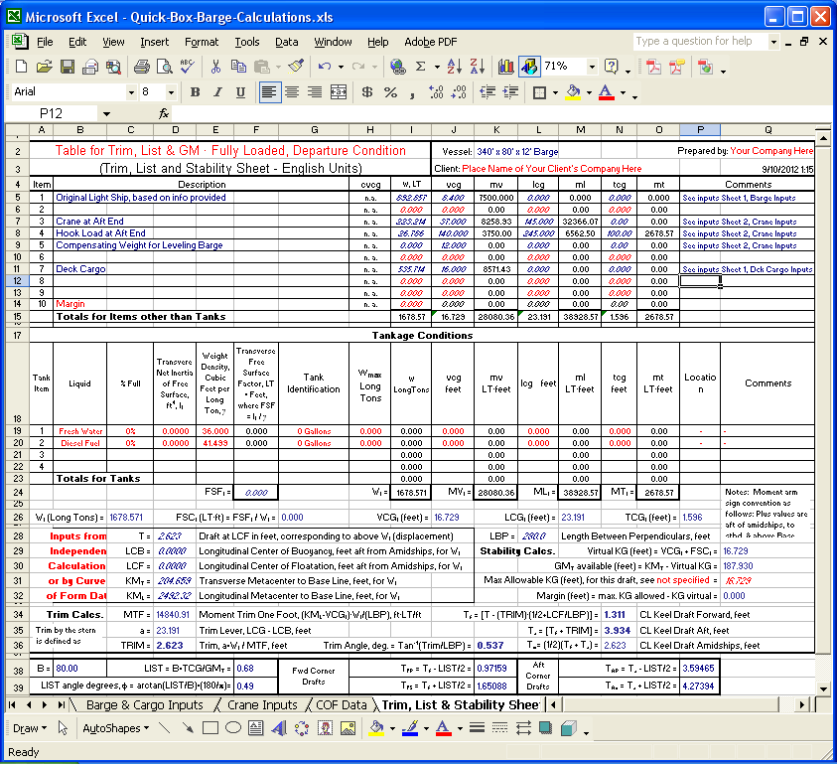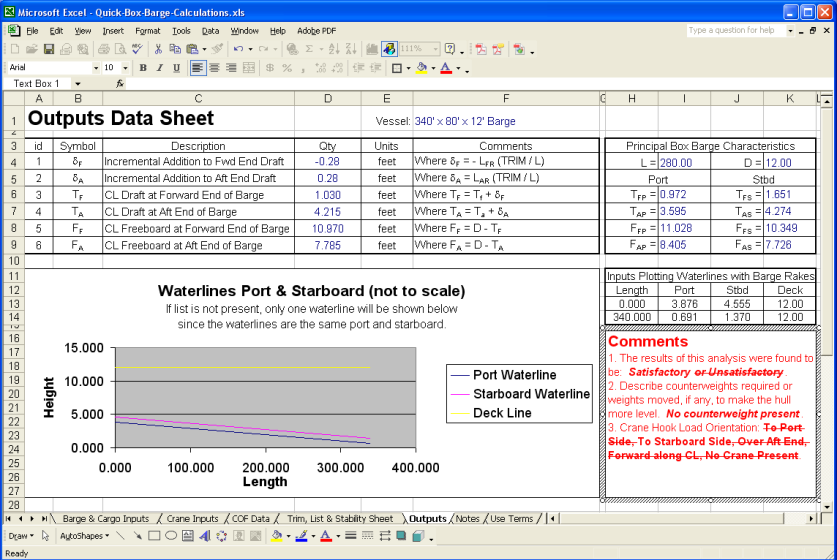Barge & Pontoon Trim, List &
GM Stability Sheet (Metric Units)
Description:
This popular spreadsheet automatically computes
trim, list, forward port and
starboard drafts, aft
port and starboard drafts,
GMs (metacentric heights: transverse and longitudinal).
It also computes total weight, all centroids of
total weight. This
calculative method applies to simple box barge,
or pontoon, or rectangular prism float.
If forward and aft
rakes are present their
hydrostatic effects are conservatively excluded. This
spreadsheet is set up to handle deck cargo and it can also compute the
stability and trim effects of a deck crane with it's hook load.
Electronic
Document Type: Microsoft Excel
Workbook
Number of
Sheets in this Spreadsheet: Eight (8)
Inputs:
The
Barge Ship light
weight and centroids The
following is required for each item on board:
-
Weights
and centroid information for deck cargo on
board, if present.
-
Weights of crane and hook
load if present.
The following are also normally required:
-
Select the weight density of water,
whether it is salt or fresh, select appropriate value, values
given.
-
The barge dimensional characteristics:
LOA, forward rake length, aft rake length, beam, depth.
-
The deck crane and hook load dimensional
characteristics:
-
height of hook load (above
crane bottom)
-
distance from barge end to center of crane rotation
-
crane radius
-
Longitudinal distance from rotation axis of crane to crane
center of gravity (for boom, cab, tracks, counterweights,
etc. every component of crane except hook load). This
distance is zero if crane boom is orientated athwartship.
This value is usually close to zero and it can be left at zero
for reasonably approximate results.
-
Transverse distance from rotation axis of crane to crane center
of gravity (for boom, cab, tracks, counterweights, etc.
every component of crane except hook load). This distance
is zero if crane boom is longitudinally oriented.
This value is usually close to zero and it can be left at zero
for reasonably approximate results.
-
Thickness of timber matt and steel plate if present.
These items often placed on the deck just below crane tracks to
distribute loading on barge.
-
Maximum Allowable
KG, this is an optional input
on Trim, List & Stability Sheet. If this value is known for
the given configuration a Margin can be calculated. If unknown,
set Maximum Allowable KG equal to zero and the spreadsheet will
automatically set the Margin value to "Not Available." Note
the variable KG is also represented as the variable VCG.
Outputs:
The total
weight and centroids of the vessel in the condition being
evaluated:
W, vcg, lcg and tcg
The
following Curves of Form data: Draft, LCB, LCF, KMT
and KML The trim
and list present, the trim
and list angles, the
centerline, port and starboard forward drafts, the
centerline, port and
starboard after
drafts, longitudinal
and transverse GMs (metacentric
heights). -
Profile of port and starboard waterlines, not to scale.
Besides a quick reference for waterline locations, this profile
is also used to quickly determine if the hull bottom has emerged out of the
water or if the barge deck has submerged.
Suggested
Reading:
Terms:
Prior to purchase, read our End
User License Terms.
Important Notice to European Union Buyers:
Due to changes in international law, we no longer accept
purchases from any individuals located within an EU country.
However, businesses located within the EU are allowed to make
purchases, provided that they make the VAT payments for any imported
items purchased electronically. These EU businesses must
specify their VAT number in the memo section on the Paypal
payment pages. These changes are effective as of July 1, 2008,
and were modified for EU businesses on April 9, 2010.
Download
Now: Click one of the following buttons to pay. After payment
you will be taken directly to the
download page.
Minimum
System Requirements: Windows 95/98/NT/2000/XP/Vista/Windows 7 & 8
Sample:
A sample document is shown below.
|





